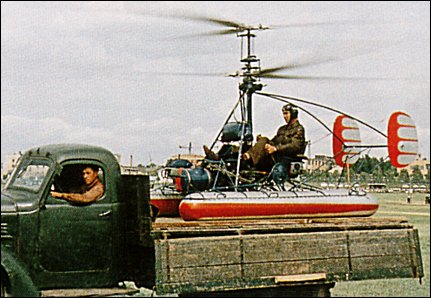Post by Stingray on Feb 7, 2008 21:40:42 GMT -4
Kamov Ka-10
1949
--------------------------------------------------------------------------------

www.aviastar.org/helicopters_eng/ka-10.php
When the Ivchenko helicopter engine became available, it was possible to develop the Ka-8 into the Ka-10, with better flight characteristics and reliability. The first Ka-10 flew in September 1949. It was followed by three more prototypes and eight Ka-10M pre-production models; the latter were distinguished by the fact that they had a different rotor assembly and an endplate fin tail unit instead of the single fin of the Ka-10. These helicopters were tested at length, but did not enter production or service.
--G.Apostolo "The Illustrated Encyclopedia of Helicopters", 1984

Success of Ka-8 enabled Kamov to open his own OKB in 1948, by which time he had completed drawings for this improved end enlarged (but still single-seat) machine. Structure similar but refined. Engine completely new, designed by Ivchenko for this application with two stages of reduction gearing, freewheel with centrifugal clutch and improved power split between rotors. Electric started and engine-driven cooling fan. First hover by D.K.Yefremov September 1949. Four built, tested by AV-MF, first Soviet deck landing 7 Dec 1950, minor improvements in Ka-10M. 12 built for Coast Guard 1954. ASCC reporting name "Hat".
--Bill Gunston "The Osprey's Encyclopedia of Russian Aircraft", 2000
Technical data for Ka-10:
Crew: 1, engine: 1 x AI-4G pistone engine, rated at 40kW, rotor diameter: 5.8m, fuselage length: 3.9m, height: 2.5m, width: 1.97m, take-off weight: 370kg, max speed: 115km/h, service ceiling: 2500m, range: 170km
1949
--------------------------------------------------------------------------------

www.aviastar.org/helicopters_eng/ka-10.php
When the Ivchenko helicopter engine became available, it was possible to develop the Ka-8 into the Ka-10, with better flight characteristics and reliability. The first Ka-10 flew in September 1949. It was followed by three more prototypes and eight Ka-10M pre-production models; the latter were distinguished by the fact that they had a different rotor assembly and an endplate fin tail unit instead of the single fin of the Ka-10. These helicopters were tested at length, but did not enter production or service.
--G.Apostolo "The Illustrated Encyclopedia of Helicopters", 1984

Success of Ka-8 enabled Kamov to open his own OKB in 1948, by which time he had completed drawings for this improved end enlarged (but still single-seat) machine. Structure similar but refined. Engine completely new, designed by Ivchenko for this application with two stages of reduction gearing, freewheel with centrifugal clutch and improved power split between rotors. Electric started and engine-driven cooling fan. First hover by D.K.Yefremov September 1949. Four built, tested by AV-MF, first Soviet deck landing 7 Dec 1950, minor improvements in Ka-10M. 12 built for Coast Guard 1954. ASCC reporting name "Hat".
--Bill Gunston "The Osprey's Encyclopedia of Russian Aircraft", 2000
Technical data for Ka-10:
Crew: 1, engine: 1 x AI-4G pistone engine, rated at 40kW, rotor diameter: 5.8m, fuselage length: 3.9m, height: 2.5m, width: 1.97m, take-off weight: 370kg, max speed: 115km/h, service ceiling: 2500m, range: 170km





